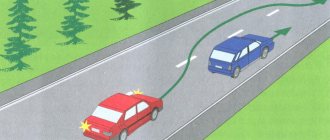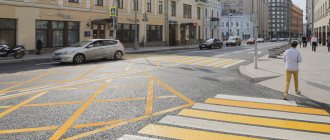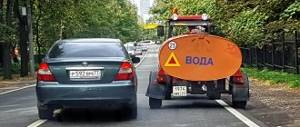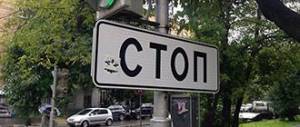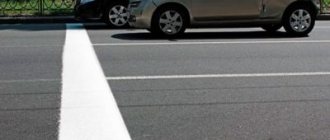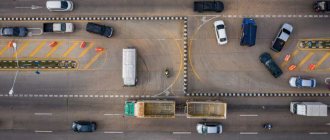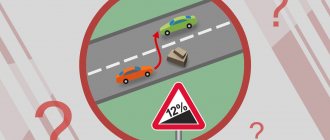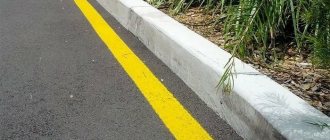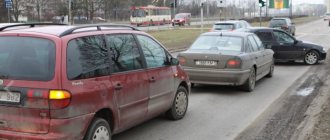On February 20, 2021, GOST R 51256 “Technical means of organizing road traffic” was adopted. Road markings. Classification. Technical requirements". The document comes into force on June 1, 2021. This GOST establishes requirements for road markings.
- New road markings;
- Safety island;
- Yellow markings;
- Road markings are blue;
- Orange markings;
- When will the new markings appear on the roads?
Let's consider the part of the standard that is of interest to road users. New types of markup have been added, for some types of existing markup it is possible to use yellow color, and blue color has been added for markup 1.7.
New road markings
Tram station
New road markings 1.17.2 - tram stops
A new type of markings 1.17, indicating stopping places for route vehicles.
Stops for trackless vehicles are indicated by markings 1.17.1 - new marking number 1.17; for tram stops with tracks located in the center of the road, markings 1.17.2 have been added. It is applied on the roadway on both sides, has a width and pitch of 1 meter. Currently not included in the Traffic Rules.
Waffle iron
- A new type of road marking 1.26, which has already received the unofficial name “Waffle Iron”.
Road markings 1.26 - waffle iron
1.26 (color - yellow) - designates a section of the intersection that is prohibited from entering if there is a traffic jam ahead along the route that will force the driver to stop, creating an obstacle to the movement of vehicles in the transverse direction, with the exception of turning right or left in the cases established by these Rules. The marking can be used independently or in conjunction with road sign 1.35.
Amended to the Traffic Rules from April 28, 2021.
U-turn
Added image of marking 1.18, indicating a turning lane.
Turn lane
Check out all the images of the new road signs.
With triangles
A yellow solid stripe in the form of triangles and zigzags (1.17) is used to visualize the boundaries of public transport stops (buses, trolleybuses and trams). In addition, “triangles” are used to show possible parking spots for a passenger taxi.
A yellow “zigzag” is applied along the edge of the roadway, along the curb. If a tram stop is located between traffic lanes, a “zigzag” can be applied to the middle part of the road.
According to traffic rules, on “triangles” it is prohibited:
- stop or park vehicles other than public transport or taxis;
- make a U-turn or move backwards.
The driver is obliged to give way to all types of public transport leaving the roadside with this type of designation. The rule applies only to the organization of traffic in populated areas.
Safety island
The markings 1.16.1 - 1.16.3 indicating guide islands have been corrected. Markup 1.1 is excluded from the image. Now we can say for sure that the island is limited by marking 1.1, and the designation 1.16.1 - 1.16.3 is applied inside this island. Previously, there was an ambiguous understanding of the use of such markings and questions remained regarding the qualification of offenses.
| Was | From June 1, 2021 |
Types of markings on the road according to traffic regulations
The types of graphic images on the roadway are described in Appendix 2 to Government Decree No. 1090 of October 23, 1993. The document was updated in 2021. What remains unchanged is that road markings in traffic rules are:
- Horizontal . These are stripes of different thicknesses and colors, continuous or dotted, arrows, and other symbols. They show in what mode the movement should be carried out on a given section of the route and inform about the important features of the section. The horizontal ones include designations from 1.1 to 1.11.
- Vertical . It consists of black and white stripes, used not only for roads, but also for their component equipment (bridges, dangerous and easy-to-travel areas, etc.). Vertical markings demonstrate the boundaries of these elements and are intended for better orientation of drivers. This type includes lines 2.1.1-2.7.
Types of markings on traffic rules roads are also presented as permanent and temporary. They are distinguished by color.
Blue markings
One of the exciting questions is: “Is it true that there will be blue markings on the roads?” Yes its true. This is marking 1.7, indicating traffic lanes within the intersection. If there are many directions of movement at an intersection, then the white color becomes motley and can only be visually confusing. Blue color seems more optimal for these purposes.
Blue markings 1.7
Three colors
The confusion began when, after the orange color, GOST was supplemented with yellow, which is used to designate zones with prohibited stopping. Yellow is similar to orange, but has different functionality.
Often yellow, orange and white stripes confuse drivers. For example, during repair work, road workers draw orange lines that cross yellow lines across white ones. The stripes fade in the sun, fade in the beams of headlights at night, and as a result, drivers are forced to drive through reconstructed sections of roads not according to the markings, but guided by instinct and eye.
Meanwhile, understanding the marking lines is not as difficult as it seems. The main color is orange. Such lanes have priority, and with their help, temporary traffic pattern corridors are designated. Orange markings are used in construction areas and are used to override white markings.
Orange markings can only be effective for a short period of time, and for it you can use unstable, erasable paints.
Question answer
Will there be a fine from the camera if the markings are not visible due to snow? The areas in front of public transport stops are now painted yellow, as well as lines along the sidewalks, indicating the coverage areas of the “no stopping” sign. The so-called “waffle irons” are also painted in yellow, that is, areas at intersections where vehicles cannot stand for more than five seconds in order to avoid blocking perpendicular roads.
Meanwhile, the rules now allow yellow markings to be used to separate oncoming traffic lanes. Experiments have shown that bright yellow color does not glare in the sun, in inclement weather it is much better visible on wet asphalt, and in winter snowfalls it is better visible through snow drifts than white markings.
What does a solid red line on the road mean?
If the requirements are not met, the driver will face a fine. You can challenge the decision of the traffic police officer using photos or video recording.
You can only refer to the poor visibility of the markings on the road (pollution, wear).
You will not be able to use color mismatch as an argument if the markings were applied with certified materials in accordance with GOST R 52289-2004 and GOST R 51256-99.
According to the method of application, there are vertical and horizontal markings. The markings used are broken and solid lines, arrows, pictograms, and their combinations.
Vertical markings, represented by a combination of white and black stripes, indicate the dimensions of road structures for visual orientation.
In some cases, in addition to color, a noise effect is used to attract the driver’s attention.
What does the yellow dashed line and solid marking line mean?
Like the previous version of the marking, it is located at the edge of the roadway along the curb, with an indent of a few centimeters from its base (10-20 cm). Implies a strict ban on stopping traffic in this area, even temporarily. Sometimes duplicated by road sign No. 3.
27, meaning “Stopping prohibited.” The line itself is displayed in the traffic rules as sign No. 1.4. There may be so-called “corridors”.
Such places where the markings are interrupted can be used for parking, if this does not interfere with the exit of other vehicles or the movement of pedestrians.
Interesting: Checking your driver's license using the traffic police database online
Residents of large settlements have recently quite often had to deal with the phenomenon of a yellow broken marking line, a yellow solid marking line, and also a broken yellow line along the curb.
It would seem that even someone unfamiliar with traffic rules knows that road markings are necessary to ensure proper movement in the lane.
Such a designation helps to better navigate the roadway, and requires repeated updating after it becomes less noticeable over time.
What are the dangers of crossing a solid marking line?
An insurmountable obstacle on the roadway may prevent the vehicle from moving along the selected lane: a pedestrian, damage to the road surface, an accident, an emergency stop of the vehicle in front, a landslide, etc. According to the rules, the driver is forced to avoid the obstacle by changing lanes on the right.
- Single line 1.1 delimits traffic flows moving in opposite directions and sets traffic limits within lanes on particularly dangerous sections of the road. Also, using this marking, parking spaces in the parking area are indicated.
- Single line 1.2.1 indicates the right edge of the roadway.
- Double line 1.3 separates oncoming traffic on four or more lane roads.
Communities › DRIVE2 and traffic police › Blog › Red markings
Today I took my license and the question was “If there are white and orange markings on the roadway and they contradict each other, what should you do in this situation?” Answer options: 1. Follow the white markings 2. Follow the orange markings 3. The rules do not regulate
So the correct answer is: 2
I have an acquaintance, a professional with more than 30 years of experience, when I learned tickets three years ago, he made more than 5 mistakes on each ticket. I think that many people forget the rules in theory, but over time they become stronger in practice. And in general, I don’t remember them in the traffic rules, but for some reason I knew about this marking.
Main elements of a highway
WATCH THE VIDEO
According to the law, the wording “road” is clearly regulated and is the main element of road traffic.
A road according to traffic regulations is a specially built or adapted piece of land for the movement of vehicles. This definition includes not only surfaces that have been developed and provided with the necessary infrastructure for the movement of vehicles, but also suburban or artificially organized ones (bridges, tunnels).
Do not forget that the road could be organized temporarily - it is intended for short-term use (during the season). This can be a specially made lane by a specialized vehicle or other vehicles in the snow or off-road. At other times of the year, cars will not drive here, but at the moment it is considered a road.
The second part of the definition contains the main elements of road traffic:
- Drive-through zone.
- Roadside.
- Sidewalks.
- Dividing strip.
- Tram lines.
Penalty for violation
For violation of temporary marking requirements, the fines are the same as for failure to comply with permanent ones.
- Turning around in a prohibited place - 500-1500 rubles.
- Failure to comply with the stop line requirements - 800 rubles. The stop line is not often drawn as a temporary one, but it is still worth knowing the consequences of ignoring it.
- For driving in the lane for fixed-route vehicles (this includes buses, trolleybuses, taxis) - a fine of 1,500 rubles. This lane is designated by the letter "A" and is separated by a solid line from the other lanes.
- Crossing a solid line - 1500 rubles.
- For crossing a double line, you can be fined 5 thousand rubles or deprived of your driver's license for six months (and for a repeated violation - for 1 year). It is important to remember that a traffic jam is not a reason for crossing solid lines or entering the oncoming lane, although the circumstances under which the violation was committed are taken into account when assigning a punishment.
The minimum punishment is a warning or a fine of five hundred rubles. If a warning is issued, then a fine cannot be issued. The maximum penalty for ignoring markings is 5,000 rubles or deprivation of the right to drive a vehicle for 3-12 months. For a repeated offense, a more severe punishment is imposed than for the first time.
The motorist has the right to challenge any punishment in court. This can be done within 10 days from the date of the decision. But it is worth considering that in order to appeal a fine there must be evidence that no offense occurred. If the markings do not comply with GOST or are poorly visible (for example, they were erased or were not visible due to snow), then you should defend your case in court.
| Did not find an answer to your question? Call a lawyer! Moscow: +7 (499) 110-89-42 St. Petersburg: +7 (812) 385-56-34 Russia: +7 (499) 755-96-84 |
The purpose of any marking is to ensure safe traffic, reduce accidents and organize order. If the lines interfere with normal traffic or are simply not removed after the work is completed, you should contact the road inspector or the traffic police.
Time marking
Temporary markings of the roadway indicate a reorganization of vehicle traffic. This means that this type of marking may contradict permanent markings and even traffic signs. In this case, the driver must follow the temporary signs.
For example, during repair work, the orange horizontal line may intersect with the oncoming traffic separation strip. But crossing even a double solid white line in this case is not a violation if the car does not leave the boundaries indicated by temporary signs. As a reminder, temporary road sign guides take precedence over road markings and permanent signs. Such signs can duplicate temporary markings or stand alone.
If the requirements are not met, the driver will face a fine. You can challenge the decision of the traffic police officer using photos or video recording. You can only refer to the poor visibility of the markings on the road (pollution, wear). You will not be able to use color mismatch as an argument if the markings were applied with certified materials in accordance with GOST R 52289-2004 and GOST R 51256-99.
Marriage during marking
Road sign “bus stop”: rules, markings, fines
First of all, when marking, defects that were made at previous stages of production emerge. Products from procurement sites or workshops, as well as materials purchased from other enterprises, reveal:
- violation of dimensions
- shape distortion
- warping.
Such castings or rentals are not subject to further marking operations, but are returned to the department or organization that caused the defect to correct it.
At the marking stage itself, defects can be caused by the following factors:
- Inaccurate drawing. The mechanic, without hesitation, displays incorrect dimensions on the part, and during further processing, defective products come out.
- Inaccuracy or malfunction of instruments. All marking tools are subject to mandatory periodic verification by the metrological service of the enterprise or an authorized metrological center.
- Incorrect use of tools or marking accessories. There are known cases when instead of calibrated measuring pads, ordinary pads were used to set the level. In this case, erroneous application of angles and slopes is also possible.
- Inaccurate placement of the workpiece on the marking table or plaza. They lead to distortions when setting aside dimensions, violation of parallelism and coaxiality.
- Wrong choice of reference planes. It is also possible that some of the dimensions were applied from the base planes, and some from the rough surfaces of the workpiece.
Marriage during marking
Separately among the reasons for defects are the marker's errors. These include:
- Incorrectly read drawing. It is possible to apply a radius instead of a diameter and vice versa, inaccurate application of the centers of holes relative to the center marks, etc. If any difficulties arise, the mechanic must seek clarification from the foreman or foreman.
- Carelessness and inattention when punching and drawing lines.
Negligence can be committed by both the mechanic himself and his supervisors, who did not check the tool on time or issued inappropriate marking devices.
Typically, marking operations are entrusted to the most experienced and responsible workers, counting on the fact that they will not mechanically transfer dimensions from the drawing to the workpiece, but will treat the matter thoughtfully and promptly notice and eliminate the reasons for possible defects on their own or by contacting their managers.
If you find an error, please select a piece of text and press Ctrl+Enter.
Horizontal markings applied across the roadway
Horizontal markings are applied across the roadway, which indicate traffic stops and crossings across the roadway, as well as artificial bumps on it.
1.12 (stop line) indicates the place where the driver must stop. This marking is applied in front of a controlled intersection and in places where sign 2.5 “Driving without stopping is prohibited” is installed. .
line 1.13 indicates the place where the driver must stop to give way. This marking can be applied in the form of a series of triangles in places where sign 2.4 “Give way” is installed. .
1.14.1 1.14.2 “zebra” indicates a pedestrian crossing, arrows indicate the direction of movement for pedestrians.
1.15 the place where the bicycle path crosses the roadway. These markings give cyclists an advantage when moving.
1.25 denotes artificial bumps on the roadway (speed bumps).
1.16.1 1.16.2 1.16.3 indicates guide islands in places where roadways divide or merge; driving onto these islands is prohibited.
The main purpose of the markings applied to the road surface is to provide information about the separation of lanes, limiting the “islands” of safety, rules and zones for parking, overtaking, as well as traffic distribution. Graphic markings can appear separately or be duplicated by corresponding road signs.
According to the method of application, there are vertical and horizontal markings. The markings used are broken and solid lines, arrows, pictograms, and their combinations. Vertical markings, represented by a combination of white and black stripes, indicate the dimensions of road structures for visual orientation. In some cases, in addition to color, a noise effect is used to attract the driver’s attention.
A detailed description of all types of graphic signs on the road is described by the Russian Federation Traffic Regulations in section Appendix No. 2, “Road markings and its characteristics” in accordance with GOST R 51256-99 and GOST R 52289-2004.
Color spectrum
If we focus purely on the provisions of the above section, then the traffic rules regulate the use of only three colors of graphic indicators:
- white (all except 1.4, 1.10 and 1.17). The designations of roadside structures are painted white and black;
- yellow - 1.4, 1.10 and 1.17;
- orange (temporary).
White color means that the graphic indicator is permanent and, if necessary, is duplicated by stationary road signs. Yellow color means parking and stopping rules. 1.4 – “Stopping is prohibited”, 1.10 – “Parking is prohibited” (the driver is given no more than 5 minutes to board and disembark passengers). Apply at the edge of the roadway or on top of curbs. Duplicated by appropriate pointers. Decree of the Government of the Russian Federation dated September 25, 2003 N 595 approves the yellow color for 1.17. The “crown” painted at the edge of the roadway means specially designated places for stopping taxis and fixed-route vehicles. If road markings are not clearly visible or their meaning contradicts the established signs, the driver must be guided by the meaning of the road signs.
Dividing strip
This is a section of road that delimits the roadway into adjacent segments. As a rule, it is fenced on both sides with a curb or other structures (lawns, metal or reinforced concrete fences).
To find out how many carriageways a given road has, you need to look at the dividing lines.
It is important to remember that this area is not intended for stops, turns and parking, but pedestrians can walk here
In some cases, it is highlighted as a straight line, so drivers often mistake it for a double solid line. It is worth considering that these are not the same thing
To understand the difference, you need to pay attention to the width between the stripes. If the space between the continuous lines is the same width as them, then it is a double solid line.
The distance between the dividing strips is much greater.
